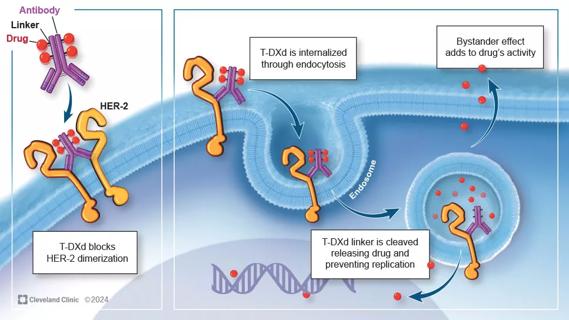Researchers consider alternatives for high-risk patients

Cleveland Clinic researchers have used routinely available clinical data to identify patients with resectable pancreatic cancer who are at high risk of early mortality. Findings from this retrospective study may lead to more individualized therapy, including aggressive preoperative chemotherapy, to improve outcomes for these high-risk patients.
Advertisement
Cleveland Clinic is a non-profit academic medical center. Advertising on our site helps support our mission. We do not endorse non-Cleveland Clinic products or services. Policy
Only 24 percent of patients who undergo surgery followed by chemotherapy — the current standard of care for resectable pancreatic cancer — are free of their cancer at five years. A significant number of patients die within the first six months following surgery. The researchers were seeking a reliable approach to identify these high-risk patients before surgery.
“They are the patients who probably shouldn’t undergo surgery right away because it’s not helping them,” says Davendra Sohal, MD, MPH, an oncologist in Cleveland Clinic’s Department of Hematology and Medical Oncology and Director of the Clinical Genomics Program. “We focused on this subgroup to try to identify those who don’t do well within the first six months after surgery.”
In the cohort study of 334 patients who underwent pancreatic resection surgery between January 2006 and June 2013, the researchers found that the high-risk Khorana score category and elevated blood urea nitrogen (BUN) values (> 25 mg/dL) were reliable in predicting early mortality. Study results were published in the June 2015 issue of Cancer.
The Khorana score, created by Alok Khorana, MD, Director of the Gastrointestinal Malignancies Program at Cleveland Clinic’s Taussig Cancer Institute, was first established as a predictor of venous thromboembolism (VTE) risk in cancer patients, and has been shown to be associated with early mortality for patients with solid tumors. This study tested its use specifically for patients with pancreatic cancer.
Advertisement
“It is a very simple score. Its components are captured on every patient in routine clinical care — blood counts, body mass index and the diagnosis of cancer itself,” Dr. Sohal says. “We feel that rather than any expensive test or intervention, this global assessment of the patient’s physiologic state reflects the ability of the person to tolerate surgery or chemotherapy or radiation.”
Previously, elevated BUN has not been shown to be associated with mortality in pancreatic cancer. There are a few studies in other cancers such as lung and a study involving patients with a variety of advanced cancers receiving palliative care that show an association between elevated BUN and mortality. But in those studies the patients also had overt kidney disease.
“This is an interesting finding,” says Dr. Sohal. “Only a small proportion of patients in our data set had overt renal failure or renal disease, so that’s not really the cause here. We think that the elevated BUN reflects some subclinical physiologic morbidity, which makes the patients either less responsive to chemotherapy or experience more toxicity from surgery or chemotherapy.”
Interestingly, BMI alone was not associated with early mortality in this study. High BMI has been shown to be associated with higher mortality in many cancers.
“The problem in pancreatic cancer is that BMI at diagnosis can be falsely low because patients have lost weight over the preceding few weeks or months,” says Dr. Sohal. “So while overweight or obese patients do poorly in most cancers, including pancreatic cancer, the low BMI at the time of diagnosis is probably the reason why it doesn’t stand out in univariable analysis.”
Advertisement
Tumor resection margin status was not associated with early mortality in this study, but it was associated with overall survival.
“This is a key finding. Early mortality depends mostly on the patient’s physiology,” Dr. Sohal says. “How healthy is the patient? Are there any comorbidities? What is the ability of the patient to tolerate surgery and chemotherapy? This is reflected in the Khorana score and BUN level.
“Overall survival depends on tumor size, resection margin status and the effect of chemotherapy and radiation. That is the difference we’re trying to understand — early mortality depends on the patient’s characteristics, and late mortality depends on the tumor characteristics.”
Because the study was retrospective, patient selection bias and missing data are potential concerns. To avoid these issues, the study focused on patients with good follow-up who were treated at Cleveland Clinic, where the research took place. However, some patients were missing data on cancer antigen (CA) 19-9 levels, a useful prognostic predictor in pancreatic cancer, thus limiting the researchers’ ability to factor it into their analysis.
“We hope that we can replicate these findings in clinical trials we are launching to try and improve the outcomes of these patients,” says Dr. Sohal.
Advertisement
“In our upcoming trials we want to see if improved outcomes are possible using aggressive chemotherapy before surgery. We will incorporate the Khorana score and BUN, which are captured in every patient anyway, and see if identifying patients at high risk of poor outcomes after surgery is possible in a prospective fashion,” he says.
Advertisement
Advertisement

First-of-its-kind research investigates the viability of standard screening to reduce the burden of late-stage cancer diagnoses

Study demonstrates ability to reduce patients’ reliance on phlebotomies to stabilize hematocrit levels

Findings highlight an association between obesity and an increased incidence of moderate-severe disease

Cleveland Clinic Cancer Institute takes multi-faceted approach to increasing clinical trial access 23456

Key learnings from DESTINY trials

Gene editing technology offers promise for treating multiple myeloma and other hematologic malignancies, as well as solid tumors

Study of 401,576 patients reveals differences in cancer burdens as well as overall survival

Enfortumab plus pembrolizumab reduced risk of death by 53% compared with platinum-based chemotherapy